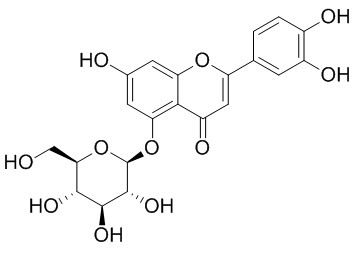Luteollin 5-glucoside
Luteolin 5-O-β-glucopyranoside has antioxidant activity, it can inhibit lipid peroxidation, and has DPPH radical-scavenging activity.
Inquire / Order:
manager@chemfaces.com
Technical Inquiries:
service@chemfaces.com
Tel:
+86-27-84237783
Fax:
+86-27-84254680
Address:
1 Building, No. 83, CheCheng Rd., Wuhan Economic and Technological Development Zone, Wuhan, Hubei 430056, PRC
Providing storage is as stated on the product vial and the vial is kept tightly sealed, the product can be stored for up to
24 months(2-8C).
Wherever possible, you should prepare and use solutions on the same day. However, if you need to make up stock solutions in advance, we recommend that you store the solution as aliquots in tightly sealed vials at -20C. Generally, these will be useable for up to two weeks. Before use, and prior to opening the vial we recommend that you allow your product to equilibrate to room temperature for at least 1 hour.
Need more advice on solubility, usage and handling? Please email to: service@chemfaces.com
The packaging of the product may have turned upside down during transportation, resulting in the natural compounds adhering to the neck or cap of the vial. take the vial out of its packaging and gently shake to let the compounds fall to the bottom of the vial. for liquid products, centrifuge at 200-500 RPM to gather the liquid at the bottom of the vial. try to avoid loss or contamination during handling.
Molecules.2020, 25(15):3353.
Drug Des Devel Ther.2023, 17:2461-2479.
Acta Edulis Fungi2020, 27(02):63-76.
FEBS Lett.2021, 595(20):2608-2615.
Anal Biochem.2019, 569:10-15
Vietnam J. Chemistry2022, 60(2):211-222
Molecules.2018, 23(3):E615
Chem Res Toxicol. 2022, acs.chemrestox.2c00049.
Food Control2022, 132:108434.
Environ Toxicol.2024, 39(3):1556-1566.
Related and Featured Products
Appl Environ Microbiol. 2003 Oct;69(10):5849-54.
Anaerobic degradation of flavonoids by Clostridium orbiscindens.[Pubmed:
14532034]
METHODS AND RESULTS:
An anaerobic, quercetin-degrading bacterium was isolated from human feces and identified as Clostridium orbiscindens by comparative 16S rRNA gene sequence analysis. The organism was tested for its ability to transform several flavonoids. The isolated C. orbiscindens strain converted quercetin and taxifolin to 3,4-dihydroxyphenylacetic acid; luteolin and eriodictyol to 3-(3,4-dihydroxyphenyl)propionic acid; and apigenin, naringenin, and phloretin to 3-(4-hydroxyphenyl)propionic acid, respectively. Genistein and daidzein were not utilized.
CONCLUSIONS:
The glycosidic bonds of luteolin-3-glucoside, Luteollin 5-glucoside, naringenin-7-neohesperidoside (naringin), quercetin-3-glucoside, quercetin-3-rutinoside (rutin), and phloretin-2'-glucoside were not cleaved.
Planta Med., 2011, 13(5):1-12.
Relationship between chemical structure and antioxidant activity of luteolin and its glycosides isolated from thymus sipyleus subsp. sipyleus var. sipyleus.[Reference:
WebLink]
One triterpenic acid (ursolic acid), one phenolic acid (rosmarinic acid), and four flavonoids (luteolin, luteolin 7-O-(6"-feruloyl)-β-glucopyranoside, luteolin 5-O-β-glucopyranoside(Luteollin 5-glucoside ), and luteolin 7-O-β-glucuronide) were isolated from the aerial parts of Thymus sipyleus subsp. sipyleus var. sipyleus and identified by spectroscopic methods.
METHODS AND RESULTS:
In vitro lipid peroxidation inhibition effects of the compounds were determined using TBA test method in a bovine brain liposome system. All compounds inhibited lipid peroxidation in various degrees except for ursolic acid. The order of the lipid peroxidation activities of luteolin, its glycosides and rosmarinic acid were: Luteolin 7-O-β-glucuronide> luteolin 5-O-β-glucopyranoside(Luteollin 5-glucoside )> luteolin 7-O-(6"-feruloyl)- β-glucopyranoside > rosmarinic acid >luteolin. However, the activity order of the compounds was completely different in DPPH radical-scavenging activity. None of the compounds shows Fe 2+ chelating activity. The results were discussed based on their chemical structures and polarities.
Food Chem Toxicol . 2012 Jun;50(6):2171-9.
Anti-inflammatory activity of Korean thistle Cirsium maackii and its major flavonoid, luteolin 5-O-glucoside[Pubmed:
22525859]
Abstract
The anti-inflammatory activity of whole Cirsium maackii (family Compositae) plants and of its major flavonoid, luteolin 5-O-glucoside, was evaluated for their ability to inhibit lipopolysaccharide (LPS)-induced nitric oxide (NO) production, inducible nitric oxide synthase (iNOS), cyclooxygenase-2 (COX-2) protein expression, and tert-butylhydroperoxide (t-BHP)-induced reactive oxygen species (ROS) generation in RAW 264.7 murine macrophage cells. The methanolic extract of C. maackii showed strong anti-inflammatory activity, and was thus fractionated with several solvents. The ethyl acetate-soluble fraction, exhibiting the highest anti-inflammatory activity potential, was further to yield a major flavonoid, luteolin 5-O-glucoside. We found that luteolin 5-O-glucoside, at a non-toxic concentration, inhibited LPS-induced NO production and t-BHP-induced ROS generation in a dose-dependent manner in RAW 264.7 cells. It also suppressed the expression of iNOS and COX-2 in LPS-stimulated macrophages. Furthermore, the efficacies of the methanolic extract of C. maackii in inhibiting both NO and ROS were attributed to its flavonoid content by HPLC analysis. These results indicated that C. maackii whole plants and its flavonoids inhibit the expression of iNOS and COX-2 in through the inhibition of ROS generation, and therefore can be considered as a useful therapeutic and preventive approach for the treatment of various inflammatory and oxidative stress-related diseases.
Copyright © 2012 Elsevier Ltd. All rights reserved.
Arch Pharm Res. 2008 Jan;31(1):28-33.
Comparative antioxidant activity and HPLC profiles of some selected Korean thistles.[Pubmed:
18277604]
As yet, no comparative analyses have been conducted regarding the comparative antioxidant activities and HPLC profiles of thistles distributed in Korea. Thus, this study was performed in order to evaluate the antioxidant potentials of seven Korean thistles: Cirsium lineare, Cirsium chanroenicum, Cirsium setidens, Cirsium japonicum var. ussuriense, Cirsium nipponicum, Cirslum pendulum and Carduus crispus, via peroxynitrite and DPPH free radical assays.
METHODS AND RESULTS:
Among seven Korean thistles, Carduus crispus exhibited the most significant antioxidant activity in both DPPH assay and peroxynitrite. In order to characterize the compounds contained in Korean thistles, we conducted HPLC analyses on the following ten flavonoids: luteolin-5-glucoside (Luteollin 5-glucoside,1), luteolin-7-glucoside (2), apigenin-7-glucoside (3), hispidulin-7-neohesperidoside (4), apigenin-7-glucuronide (5), cirsimarin (6), pectolinarin (7), luteolin (8), apigenin (9) and acacetin (10).
CONCLUSIONS:
The results of our HPLC analyses indicated the presence of pectolinarin in the whole plants of C. setidens, C. lineare, C. nipponicum, C. pendulum, the aerial and underground parts of C. japonicum var. ussuriense, and the aerial parts of C. chanroenicum. Moreover, we were able to identify hispidulin-7-neohesperidoside and luteolin-7-glucoside in the whole plants of Carduus crispus, acacetin in the aerial parts of C. chanroenicum, cirsimarin in C. lineare.



